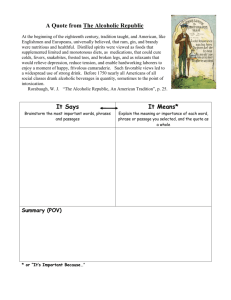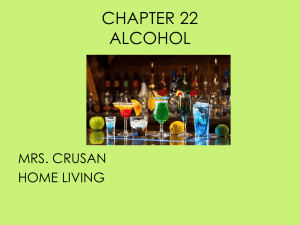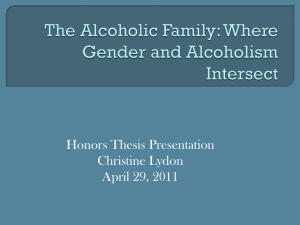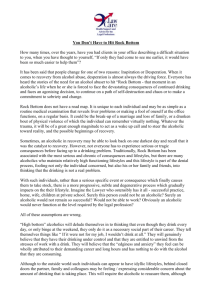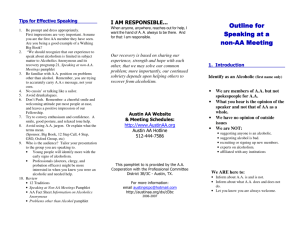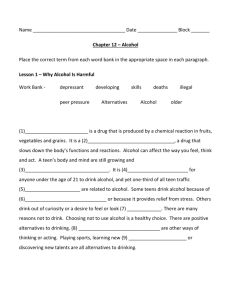-
advertisement
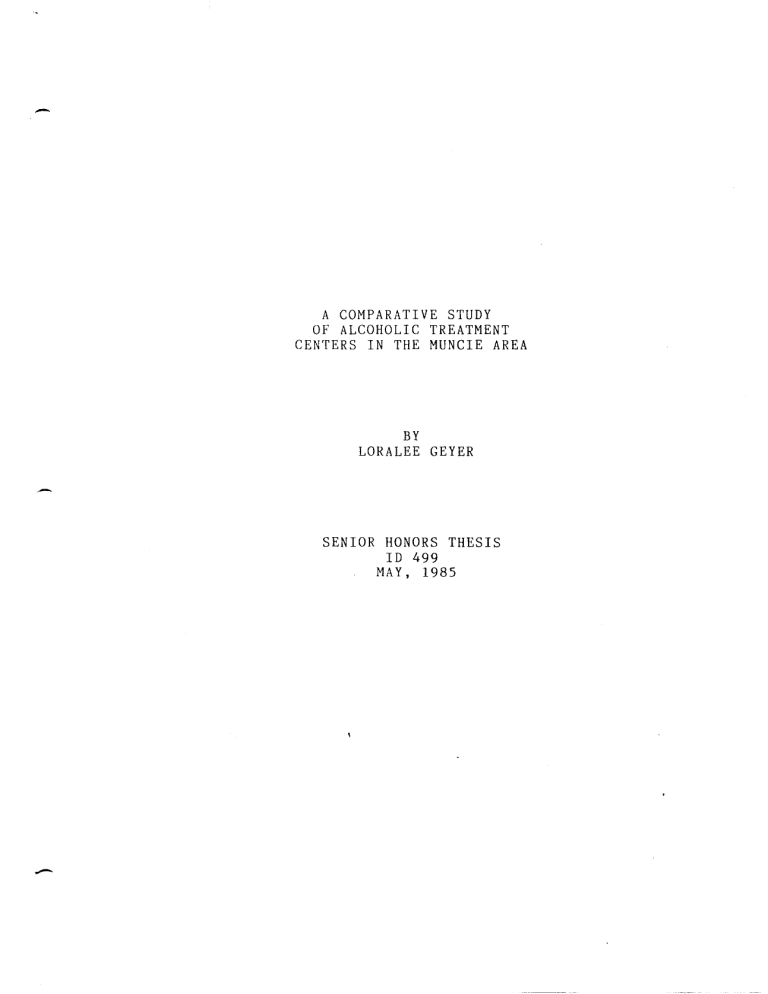
-
A COMPARATIVE STUDY
OF ALCOHOLIC TREATMENT
CENTERS IN THE MUNCIE AREA
BY
LORA LEE GEYER
SENIOR HONORS THESIS
ID 499
MA Y, 1985
-
,
~,~
•
.
. .. ;.' ,)
TABLE OF CONTENTS
-
--
I.
The Disease of Alcoholism
II.
Differences of in patient and out patient services
III.
The Middletown Center for Substance Abuse
IV.
The Jackson Clinic
v.
The Aquarius House
VI.
The Responsible Action Program
\~.
Alcoholics Anonymous
vm.
AI-Anon/ Alateen
I.
ALCOHOLISM
A problem drinker
creates a
spouse,
ing,
a~3
problem.
is anyone for whom the use of alcohol
Problems may occur with friends or a
or with the police.
Increased frequency of drink-
well as increased tolerance of alcohol may also be
a sign of problem drinking.
While a
problem drinker can
stop drinking because he or she is not addicted to alcohol,
Problem drinkers may be on their way
an alcoholic cannot.
to becoming alcoholics.
Once an alcoholic begins to drink,
he or she cannot normally cOfltrol how long or how much they
will drink because they are psychiologically and
dependent upon it.
physically
Recognizing alcoholism as a disease im-
plies several things:
1.
The illness can be described.
2.
The cause of the illness is predictable and progressive.
3.
The disease is primary -
that is,
it is not
just
a symptom of some other underlying disorder.
4.
It is permanent.
5.
It is terminal -
if left untreated,
it inevitably
results in premature death.
A common self defense that most alcoholics use is that
of denial.
They deny
that they have an alcohol problem and
they keep making excuses for
their drinking.
Denial takes
3
First,
two major forms.
the alcoholic insists that he or
she can drink like other people,
socially and normally.
This means that there are always ready excuses for the
exceptional times rests,
for
the fights,
the drunk driving ar-
for the blackouts and the incapacitating hangovers.
The alcoholic always thinks situations like these are someWhether it is harassment from the boss,
one else's fault.
too much pressure from the family oA just bad luck,
coholic always thinks i t ' s someone else's fault.
the al-
Secondly,
the alcoholic insists that he or she is different from
There is always an example of a "real"
"real" alcoholics"
alcoholic who serves as a model of alcoholic degeneration unkempt,
jobless,
"strange" side.
homeless,
friendless and a little on the
Therefore, an alcoholic in the stage of
denial is convinced he or she is not a "real" alcoholic.
Treatment for alcoholism is available.
alcoholics are aware of this,
many years.
Although many
they delay seeking help for
By using the denial defense, most alcoholics
won't admit they have a
problem and need help.
takes many years of conflict,
treatment is sought.
It usually
trouble and heartaches before
The alcoholic isn't the only one who
makes excuses for his or her drinking habits.
A spouse that
"puts up with it" or makes excuses for the drinker is only
enabling the alcoholic to hide his or her problem and continue drinking.
-
Also,
the employer who is aware of an em-
ployee's excessive drinking isn't doing anyone a favor
by
letting the alcoholic slide in order to keep his job or his
pride.
He is only giving the alcoholic more time and excuses
to drink.
4
Often
those closest to an alcoholic find
it hardest
to see and admit that someone they care about is an alcoholic.
The spouse of an alcoholic
he or she doesn't drink.
becomes a co-alcoholic even if
The alcoholic forces his problem
on his spouse by making his alcoholism the focal
their lives.
For example,
if the husband is an alcoholic,
chances are his wife cleans up after him,
him at work when he's drunk or hungover,
for not going out
point of
calls in sick for
and makes excuses
to parties or dinner with friends when
he is out drinking or is too drunk to go.
Soon,
the family
plans and activities are centered around the father's drinking and how he feels situta~ions
physically.
This usually leads to
where the spouse is abused,
alone,
and yet is responsible for the children,
has no money
if there are any.
This type of situation will most likely continue until the
spouse confronts the alcoholic giving him either natives and sticking to them.
or alter-
An example of these alterna-
tives would be telling the alcoholic to quit drinking and
get help or else the spouse and children are moving out
(or
in some cases the spouse asks the alcoholic to leave).
This
confrontation limits the alcoholic's actions and forces him
to decide which is more important to him,
his family or his
drinking.
In a family where the parent or parents are alcoholics,
the children are also greatly affected.
Some children must
cope with fear of the alcoholic and fear of physical abuse
by the alcoholic.
Eventually,
the children become ashamed
of their alcoholic parent(s) and don't want to do things
5
-
like bring friends home with them in case the alcoholic is
drunk,
obnoxious or fighting with the spouse.
the children don't w~nt
any school related
their alcoholic
functions
up drunk and cause a scene.
for
fear
parent to come to
that they might show
The children in an alcoholic
family are usually very close to one another,
support and protective reasons.
angry and hateful
is apt
broken which causes
towards the alcoholic.
Also,
the parent since all
There are usually four
to survive in an alcoholic home.
,-
for
the kids and usually leads them to feel
tend to lose respect for
existent.
mainly
Promises made by the alco-
holic to the children are frequently
mu£h heartache for
Sometimes
to be very responsible,
for others in the family.
the kids
trust is non-
roles that allow children
An only or eldest child
not only for
himself,
but
A child who takes on the role of
the adjuster follows directions easily and is flexible as
to
avo~d
making any conflicts.
the placating child.
feel good and laugh,
holism"
The third role is that of
This person often tries to make others
as
if he feels guilty for
the alco-
The last role is that of the lost child.
children detatch themselves,
These
removing themselves emotionally
from an environment which they cannot control or effect.
Alcoholism takes no standard form.
females,
It
It happens to males,
old and young alike and has no favorites among them.
af fect s
s po use s
in
strates the need for
f ami 1 i e s i n the war s twa y w h i c h d em 0 n family
therapy,
which most
treatment
centers offer in addition to individualized treatment for
6
-
for
the alcoholic.
Most
therapists think that they must
change the environment which is conducive to the drinking
habits of the alcoholic and this includes treating the
family.
-
7
-
II.
IN PATIENT One of
OUT PATIENT
the main differences between alcoholism treat-
ment centers is whether it offers an in-patient or outAn in-patient
patient service.
treatment plan is designed
so the patient actually lives at the hospital or treatment
center for
the duration of his or her therapyo
patienc is admitted,
he or she eats,
Once the
sleeps and goes to
therapy sessions without going home or leaving the center.
These types of treatment centers are usually based on a
treatment plan lasting roughly one month.
completes this stage of treatment,
and is required
After the patient
he or she is released
to return to the center for
the aftercare
program which is usually one or two times per week for a
therapy session.
Although the treatment
than out-patient treatment,
rigid and intense.
per day,
everyday,
is greatly changed.
program is shorter
in-patient therapy is much more
The patient is treated twenty-four hours
for one month and his or her lifestyle
There is constant support from other
patients and staff members and there are no outside environmental deterrants to the therapy treatment.
The alcoholic
receiving in-patient treatment doesn't have to cope with any
outside responsibilities and can focus his attention solely
on treating his problem away from his "normal drinking"
environment.
Out-patient therapy includes clients who visit a
or
-
off~ce
few hours
anywhere from one to five
to receive treatment.
clinic
times per week for a
The treatment program is
8
longer in length,
somewhere between six months and two years,
but only requires a
four
few hours
hours a day as with
per week instead of twenty-
in-patient therapy.
The out-patient
treatment isn't quite as effective as in-patient treatment,
but is usually more convenient and affordable for most clients.
However, more people tend to quit going to their weekly sessions than do people involved in an in-patient program.
This
is due partially to the high cost and intensity of the inpatient service. whether an alcoholic chooses to attend an
in-patient program or an out-patient program isn't that crucial;
the choice is usually the result of which program is convenient,
affordable,
available and fits
portant point is that
she has a
the alcoholi2s needs.
The im-
the alcoholic has realized that he or
problem with alcohol and has chosen to receive some
type of treatment.
no treatment at all.
After all,
any
treatment is better than
9
-
ill.
THE MIDDLETOWN CENTER
The Middletown Center for
chemical dependency is an in-
patient treatment center located in Ball Memorial Hospital.
This
is a
fairly new service to the Muncie area as it has
only been operating since November,
1983.
The Middletown
Center is based on the medical model of alcoholism which
finds
that alcoholism is a disease;
disease and it isn't their fault
people don't want this
that they have it.
Alcoho-
lics have an illness which needs medical attention and treatment designed to treat the whole person.
Trained profes-
sionals work to meet each patient's physical,
psychological,
interpersonal and spiritual needs.
Clients are referred to the Middletown Center by employers and families and some just walk in themselves.
hasic
treatment involves a
twenty-eight day plan where the
patient is kept in the hospital for
ever,
The
the entire session.
How-
specific treatment plans are made for each individual
according to his or her needs.
This is a
very structured
and rigid program and requires complete dedication by each
patient.
The cost of this treatment is four
thousand dollars
per month and this includes the patient's twenty-eight day
treatment plan,
of aftercare.
short
time,
one week of family counseling,
and two years
This may seem like a lot of money for
such a
but you must remember that the patient's live
at the center for the entire month and eighty percent of the
patients who follow through their specific plans recover.
Also,
most insurance does pay for all or most of the treatment
fee and there is no additional cost for
the family
or aftercare as there is at some other centers.
therapy
10
The Middletown Center can accomodate twenty-eight patients at one time and it is usually full
to capacity.
Middletown Center's average patient is a forty-five
male,
is a
blue collar worker who has an alcohol
3:1 male to female
problem.
ratio at the center.
The
year old
There
Ninety-five
percent of the patients treated are heavily involved with
the alcohol,
although there are some patients who have pro-
blems with drugs other than alcohol.
As I
stated earlier,
evaluation,
the family therapy),
PHASE I:
very intense structured
There are three phases to the twenty-
treatment program.
eight day plan;
this is a
primary treatment
(This includes
and aftercare.
Evaluation
Following admission,
all
patients are monitored closely
by the medical staff to ensure safe withdrawal from moodaltering chemicals.
This is referred to as detoxification
and is done in rooms equipped with special machines and equipment
to monitor
the patients behavior and condition.
This
process of detoxification can take anywhere from one to three
days,
depending on the
patient's condition.
Although each
patient must stay in the detoxification room for at least
twenty-four hours,
some never show any withdrawal symptoms.
Once the patient is satisfactorily detoxed,
seling staff
begins to assess
well as his or her social and
structured interviews and
-.
the coun-
the patient's chemical use as
psychological histories through
psychological testing.
The patient
is oriented to the disease concept of chemical dependency,
Ii
-
Based on the as-
group therapy and the treatment program.
sessments,
the couseling staff makes recommendations that
become the basis of each patient's treatment plan.
PHASE H:
Treatment
Each patient is assigned to a multi-disciplinary team
which consists of a
selor,
for
physician,
a chemical dependency coun-
nurses and a spiritual care counselor.
A normal day
the patients involves getting up at 5:00 aom.
ticipating in groups,
lectures,
meals,
and par-
discussions and
speaker lectures until about 9:00 p.m.
The treatment helps
each patient identify and share his or her feelings of inadequacy,
hurt and anger with
peers and concerned persons.
The patients usually go to bed early since their day is so
busy and they get very
for
socializing,
tired.
There is a
watching movies,
if patients want to.
lounge available
reading or playing cards
The center also sends the patients to
the Iluman Performance Laboratory at Ball State University
for
one hour each day so they can participate in an exercise
program.
This varies from walking one mile to jogging five
miles according to each patients physical tolerance.
The
staff at Niddletown believes that patients who are involved
in any type of regular activity program have a higher recovery rate.
The patients at Middletown are only able to
have visitors for
Phase
-
two hours on the weekends.
H also includes the family program.
Since chem-
ical dependency seriously affects those who are close to the
chemically dependent person.
The family
program provides
12
group therapy,
with family
lectures,
problems,
these issues.
selected readings,
assistance
and help in developing plans to resolve
The family
program lasts five days.
It be-
gins on a Monday and concludes on Friday and runs from 8:00
a.m.
tc 3:00 porn.
PHASE lIT:
each day.
Aftercare
Adopting new lifestyles for
friends requires time,
the patient,
care and support.
charge from primary treatment,
family and
Prior to dis-
the patient meets with an
aftercare counselor to discuss problems related to sobriety
and to develop an Aftercare Plan.
Each patient will
be as-
signed to a weekly support group to provide direction and
sobriety.
patients,
for
The aftercare program is available to discharged
family members and co-dependents (friend or spouse)
two years.
13
JACKSON CLINIC
IV.
The Jackson Clinic is a
located at 3300 S.
private out-patient clinic
This clinic
Main Street in Anderson.
provides services for adult and child guidance and anxiety/
fear/phobia
problems as well as an addiction s2rvices pro-
The clients they serve may walk in themselves or be
gram.
referred
to the clinic by
or other family members.
fairly
young,
physicians,
employers,
the courts
Most of the clients they
usually early
to late thirties,
short history of drinking and/or divorce.
treat are
who have a
The clinicians
at Jackson treat more alcohol related problems than drug
related problems.
denial feeling.
These clients don't usually have a
As
I
stated earlier,
rigid
this clinic provides
out-patient services so the treatment isn't quite as intense
or rigid as an in-patient treatment center.
Jackson Clinic consists of twelve clinicians,
work part time
(20-30 hours per week).
The staff at
most of whom
The staff is com-
prised of professionals in the areas of psychiatry,
logy,
psychiatric social work and specialized substance abuse
counselors.
a
psycho-
A counsulting physician is available to evaluate
clients need for
ieals.
On a
nine clients;
detoxification or withdrawal from chem-
busy day,
on a
a clinician will see approximately
slow day,
Prior to admission,
one.
the client will be screened by a
staff ~ember to determine what
if the clinic is suitable for
the client's needs are and
the
treatment.
The staff mem-
ber helps the client determine if another alternative treatment program would be more beneficial. for
the clients recovery.
14
-
Through this assessment,
an individual treatment
program
will be developed to determine the length of treatment and
The list that follows consists of questions
degree of needs.
frequently asked new clients to assess their degree of alcoholism and
to find out the history
behind their problems.
1.
What was your age when you started drinking?
2.
What was your age when you started drinking on a
regular basis?
3.
When did you realize that you had a
4.
Have you ever had blackouts?
5.
Did you notice a gross personality change?
6.
Has anyone ever suggested that you quit drinking?
7.
Have you ever been arrested due to alcohol?
8.
Have you had any alcohol related medical problems?
Are they frequent?
After the client answers these questions,
checks his or her answers with a
if the answers given are correct.
different answer,
problem?
the staff double
spouse or relative to see
If the spouse gives a
the staff member will
believe the spouse
because sometimes the alcoholic will tend
to give answers
that will help him or her keep their drinking habit.
thing the staff member tries
One
to uncover is the reasons that
people drink and then try to break the habits.
The Jackson Clinic focuses mainly on individualized
treatment,
but
eluded in the
family members and significant others are intreatment process when possible.
Group therapy
is an additional component offered along with the individualized and family
sessions.
would consist of four
An example of a
treatment
hour sessions on Monday,
program
Tuesday,
15
Thursday and Saturday with Monday and Thursday being therapy
discussions and problem solving and Tuesday and Saturday being
An aftercare program will
educational lectures and movies.
follow the intensive phase and will assist clients as they
start their new lifestyle.
The length of the treatment is
determined on an individualized basis.
type of treatment
is eighty dollars for an initial visit
with the psychiatrist and
succe~ding
The cost of this
then thirty-five to forty
visit with the psychiatrist.
for each
It also costs sixty-
five dollars per hour for
consultation and
of the other clinicians.
However,
therapy with one
some of this cost may be
paid by insurance depending on the particular insurance com-
The Jackson Clinic
is in
the process of developing a
new program whicll would consist of four weeks of intense treatment and
then monthly visits for
the following
year.
This
program would involve more group therapy and the sessions
would be three hours twice a week.
would only
Clinic will
The cost of the program
be fifteen dollars per hour.
However,
Jackson
not turn people away if they are unable to pay
the regular fees
for
the current or new program.
They will
set up an individual payment plan so treatment can still be
given.
16
-
V.
AQUARIUS HOUSE
The Aquarius House is a
out-pa~ient
publicly funded substance abuse
counseling and information center located at 413
South Liberty Street in Muncie.
Aquarius House is a non-
profit corporation which was established in January of 1971
in res)onse to the growing number of young people who were
experiencing drug related problems.
The Aquarius House
also provides services for women in violence which provides
short
term counseling for
program for
rape victims,
youths twelve to eighteen,
a
youth awareness
and a public educa-
tion program consisting of films and lectures.
offer a
They also
twenty-four hour hotline for the community dealing
with drug,
alcohol or related problems.
The hotline is
staffed by community volunteers.
Seventy-five percent of Aquarius House Clients are referred
to them through the legal system.
who have been arrested for
Many are people
drunken driving and have been
given counseling in conjunction with a
probation sentence.
Aquarius House dues take other referrals and walk-ins also.
Eighty percent of the clients using Aquarius House services
are Male.
This clinic serves all ages of clients;
particu-
larly between seventeen and
twenty-five years of age and many
of these people are single.
The clinic is staffed by approx-
imately ten professionals,
all of whom hold bachelor degrees
and some also have masters and doctoral degrees.
The clinic treats more alcohol
-
related.
During an average month,
related cases than drug
two hundred clients will
17
visit tie clinic roughly une
previously,
this program
js
time
strictly a
in-patient treatment center for
drug and alcohol
detoxification or other rea-
are discussed on a
patient's initial
On the next visit,
the client will see a
tify the problem or
visit
to determine if there is a
not
they used
to Aquarius House.
counselor to iden-
is done through testing and questionnaires.
but that
stated
The payment plan and method of treatment
necessary~
clients are found
As I
The staff will refer clients to an
out-patient service.
sons if
per week.
bad
to have a
problem.
This
Many of the
serious drinking problem,
judgment in a certain situation.
The
average client visits the clinic one to two times per week
Seventy-five percent of
for counseling.
done on an individualized basis,
is group therapy.
Although
mined according to personal
statistics for
while twenty-five percent
The counselors like to include the family
whenever possible.
gram runs for
the treatment is
the length of
needs,
less than one year.
treatment is deter-
the average
treatmeqt
pro-
The following is some
1983:
36% of the clients had
1-2 sessions.
48% of the clients had 3-9 sessions.
16% of the clients had
At Aquarius House,
10 or more sessions.
clients do have the right to stop counsel-
ing at any
time whether or not your counselor agrees with your
decision.
However,
with a
counselor
terminations should always be discussed
(or probation officer,
counseling is terminated.
if necessary)
before
18
!\q\l;\rill:->
fee
110:1:;('
is
plli,i iciy
[llll(led,
although a
is charged to each client to maintain a
Ninety-five percent of
cording to units of
the
funding
service given.
quality program.
is done by the state acAquarius House is sup-
ported by the National Institute on Drug Abuse,
Department of Mentol
Health;
small
the Indiana
Division of Addiction Services,
community contributions and voluntary energy.
The fee each
client is asked to pay is based on his or her income and dependents.
Seventy-five percent of the clients pay two-twelve
dollars per session.
However,
treatment due to inability
.-
Aquarius House will not refuse
to payo
19
~.
RESPONSIBLE ACTION PROGRAM A~uarius
House,
Ball State University/
Inc.
The Professional Psychological Clinic of Ball State
Univerity and Aquarius House,
Inc.,
have
joined together to
design a drug and alcohol education program.
is available for
individuals with alcohol and drug problems
related to courL charges,
are referred
system,
employment or family.
to this treatment
employers and concerned persons.
educational media.
group interaction and
The program is presented by
professional staff from Aquarius House and
Ps~chological
ents,
Individuals
program through the court
The program consists of lectures,
is a
This program
Clinic staff.
both the
the Professionsl
The Responsible Action Program
two-day (weekend) workshop.
It provides seven compon-
which are:
1.
orientation alld explanation to the participant of the
program and i t ' s requirements;
2.
an evaluation of the participant's psycho-social
functioning
as
they
in regard to use and abuse of substances
relate
to social relationships,
family and
vocation;
3.
education in alcohol and drug use and abuse and assessment of need for further
4.
selected psychological
treatment;
testing will be conducted as
part of the evaluation process in assessing recommendations and
5•
referral
referral suggestions;
to appropriate community resources,
if indicated;
20
6.
-
coordin~tjon
and communication with court officials
and employers;
7.
and
fol1ow-up with the participant upon completion of
the program to evaluate individual and program success.
Most people who attend are between 17-25 years of age
and there are more male participants than female.
age size group for
the weekend is between ten and fifteen
and most of them are first
five
An aver-
time offenders of the law.
to ten percent are Ball State students while the re-
mainder is made up of quite a
few out of state college stu-
dents who are originally from this area.
one hundred dollars for
insurance.
The program costs
the weekend and is not covered by
This program has
been very successful thus far
as very few people who attend are arrested again after
ticipating.
-
About
par-
21
VIT.
ALCOHOLICS ANONYMOUS
Alcoholics Anonymous
is a
voluntary,
worldwide fellow-
ship of men and women from all walks of life who meet
ther to attain and maintain sobriety.
The only requirement
for membership is a desire to stop drinking.
the foundation of Alcoholics Anonymous.
histories and no membership list.
fees for
toge-
Anonymity is
They keep no case
There are no dues or
A.A. membership, although some local chapters "pass
the hat" at group meetings to help with the building rental
and other meeting expenses such as coffee and sandwiches.
A.A. is entirely self-supporting and no outside contributions
are accepted.
A.A. was started in 1935 by a New York stock-
broker and an Ohio surgeon (both now deceased),
-
They
"hopeless" drunks.
who had
A.A. in an effort to help
founded
others who suffered from the disease of alcoholism and
stay sober themselves.
States and world.
been
to
A.A. has grown throughout the United
There are local A.A. meetings held during
the week in the Muncie area and can be contacted through the
telephone directory.
A.A. is a program of total abstinence.
Members stay away from one drink,
one day at a
is maintained through sharing experience,
time.
Sobriety
strength and hope
at group meetings and through the suggested twelve steps
for
recovery
1.
which are as follows:
We admitted we were powerless over alcohol our
2.
from alcoholism,
that
Jives had become unmanageable;
came to believe that a
power greater than ourselves
could restore us to sanity;
22
3•
III ;1
dP
<l
d ( ' I i sin II
I ()
t
1I
rn
0
ur
wi 1 1 a
11
d
urI i v e s
0
0
ve r
to the care of God as we understood him;
4.
made a
searching and
fearless moral inventory of
ourselves;
5.
admitted to God,
to ourselves,
and
to other human
beings the exact nature of our wrongs;
6.
were entirely ready
to have God remove all
these
defects of character;
7.
humbly asked him to remove our shortcomings;
8.
made a
list of all persons we had harmed and be-
came willing to make amends to them all;
9.
made direct amends to such people where ever possible,
except when to do so would injure them or others;
10.
continued to take personal inventory and when we
were wrong,
11.
promptly admitted it;
sought through prayer and meditation to improve our
consious contact
with God as we understood Him,
ing only for knowledge of His will for
power
12.
the
to carry that out;
having a
steps,
us and
pray-
spiritual awakening as the result of these
we tried
to carry this message to alcoholics
and to practice these principles in all our affairs.
Anyone may attend open meetings of A.A.
consist
of
talks by a
designated group leader and two speakers
who share experience as it
their recovery in A.A.
fic
purpose of
They usually
informing
relates to their past illness and
Some meetings are held for
the non-alcoholic
Closed discussion meetings are for
the speci-
public about A.A.
alcoholics only.
Meetings
23
usually last approximately one hour and the group meets once
per week.
However,
a
person could go to an A.A.
meeting
just
about every night of the week at different meeting spots as
there are usually
that many
held each week.
research,
The group does not
or make medical
out services,
food,
join councils or social organizations.
follow up or
prognoses.
try to control
A.A.
i t ' s members
also does not provide drying
offer religious services or provide housing,
clothing,
members.
does not
They do not engage
keep membership records or case histories.
in or sponsor
A.A.
jobs,
money or other welfare services to its
No letters of
reference
to parole boards,
court officials or employers are provided
by A.A.
lawyers,
either.
There are also twelve traditions of Alcoholics Anonymous:
1.
Our common welfare should come first;
recovery
2.
dependes upon A.A.
For our group purpose,
authority -
a
3.
The only
unity.
there is but one ultimate
loving God
3S
in our group conscience.
serviJnts;
our personal
he may express Himself
Our leaders are but
trusted
they do not govern.
requirement
for A.A.
membership is a
desire
to stop drinking.
4.
Each group should
be antonomous except in matters
affecting other groups or
5.
A.A. as a whole.
Each group has but one primary purpose -
to carry
its message to the alcoholic who still suffers.
6.
An A.A.
group ought never
the A.A.
terprise,
to endorse,
name to any related facility
lest
problems of money,
tige divert us from our
finance or lend
or outside en-
property and pres-
primary purpose.
24
7.
1< v ( . ry II. II.
1'. r
(J
II
P () II) '. II
t
t ()
I> e
f
LJ
declining outside contributions
8•
II leo Ii () lies All 0
II
professional,
but
1 1 Y s elf - sup p 0 r tin g
o
YIII 0 us s h 0 u 1 d rem a i n for eve r
non-
our service centers may employ
special workers.
9.
A.A., as such,
ought never be organized;
but we
may create service boards or committees directly
responsible to those they serve.
10.
A.A.
has no opinion on outside issues;
hence the
A.A.
name ought never be drawn into public con-
troversey.
11.
Our public relations policy is based on attraction
rather than promotion; we need always maintain personal anonymity at the level of press,
radio and
films.
12.
Anonymity is the spiritual foundation of all our
traditions,
ever reminding us to place principles
before personalities.
Since Alocoholics Anonymous is a voluntary,
organization,
coholics.
uncommitted
it is very convenient and attractive to al-
There is no rigid treatment program to follow,
no restrictions and no fee
for
treatment.
All of the therapy
is done by alcoholics helping each other and so far,
been very successful.
,-
A.A. has
25
Vlll.
AL-ANON / ALATEEN
AI-Anon Family groups are a
who are husbands,
holies.
had found
wives,
AI-Anon was
fellowship of men and women
relatives or close friends of alco-
founded
by families of alcoholics who
The AI-Anon pro-
sobriety in Alcoholics Anonymous.
gram shows people how to cope with difficulties associated
to their loved one's drinking and to find a more positive
approach to life.
Improved attitudes by family members and
friends may also influence the alcholic to seek the help he
Many
or she needs.
times those closest to an alcoholic are
the ones who suffer the most from the drinkingo
AI-Anon
offers support to these people by letting them share their
similar experiences.
to realize that
It is difficult for a
non-alcoholic
the alcoholic did not deliberately and will-
fully get into his present condition;
that
drin~ing
the
has
become a compulsive urge which he cannot control by himself.
The alcoholic needs encouragement and understanding both
before and after he has become sober.
to come from family
and
This support needs
friends and these people need
what to expect and how to handle situations.
to know
AI-Anon has
weekly meetings similar to Alcoholics Anonymous where one
or more members will give short talks and occasionally have
a
question and answer session.
philosophies which parallel
or charge for
-
those of A.Ao
these meetings.
and reassurance
AI-Anon follows
twelve basic
There is no
fee
AI-Anon just gives support
to those close to an alcoholic,
who in turn,
may be able to help the alcoholic and make their lives more
controllable.
26
J
iJ:-; t
:1:-;
t
h ('
of alcoholics,
i:-; n
t'l'
:-;
II
P P () r t
gr
there is also help
usually teenagers,
whose
0
u p for
for
fa mil y and
young AI-Anon members,
lives have been affected by someone
These young people come together in a
else's drinking.
group called Alateen to share experiences,
with each other,
discuss difficulties,
that compulsive drinking
is a
hope
learn ways to cope
disease and
tatch themselves emotionally from
while continuing to love the
and
strength and
Members of Alateen also learn
and encourage one another.
are not
f r i end s
that they can de-
the drinker's problems
person.
These young people
the cause of anyone else's drinking or behavior
they cannot control anyone
but
themselves.
lifestyles Alateen members may have now,
satisfying and rewarding lives
for
Despite the
they can develop
themselves.
Every Ala-
teen group needs an active adult member of AI-Anon to serve
as a
sponsor.
The spa n SOL'
sharing knowledge of the
is a n act i v epa r t
twelve steps and
oft h e
g r au p
traditions.
AI-Anon and Alateen group meetings are held in hospitals,
rehabilitations facilities,
residences.
There are
1.
Closed -
2.
Open the
3.
for
for
families
three types of meetings:
those considering membership.
people interested in learning more about
program.
"Meeting-on-wheels" a
clinics and abused
open to all and consists of
brief presentation of an AI-Anon/Alateen meeting.
Experienced AI-Anon and
Alateen members conduct
There is no charge to attend either one of
these meetings.
these meetings.
These groups are supported by members of regular groups,
27
Districts,
Institution Committees and Information Services.
Information concerning
a
telephone directoryo
these groups can be obtained through
28
BIBLIOGRAPHY
I.
Alcoholism
pamphlets
ill.
M~Lddletown
IV.
V.
VI.
,-
VII.
VIII.
Center
Drew Edwards pamphlets
Jackson Clinic
Vann Hudson pamphlets
Aquarious House
Bill Calvert pamphlets
coodinator and counselor
clinician
counselor
Responsible Action Program
Fred Evans - counselor
pamphlets
Alcoholics Anonymous
pamphlets
personal visit to A.A.
Aldteen/AJ-Alloll
pamphlets
(Aquarius House)
meeting
